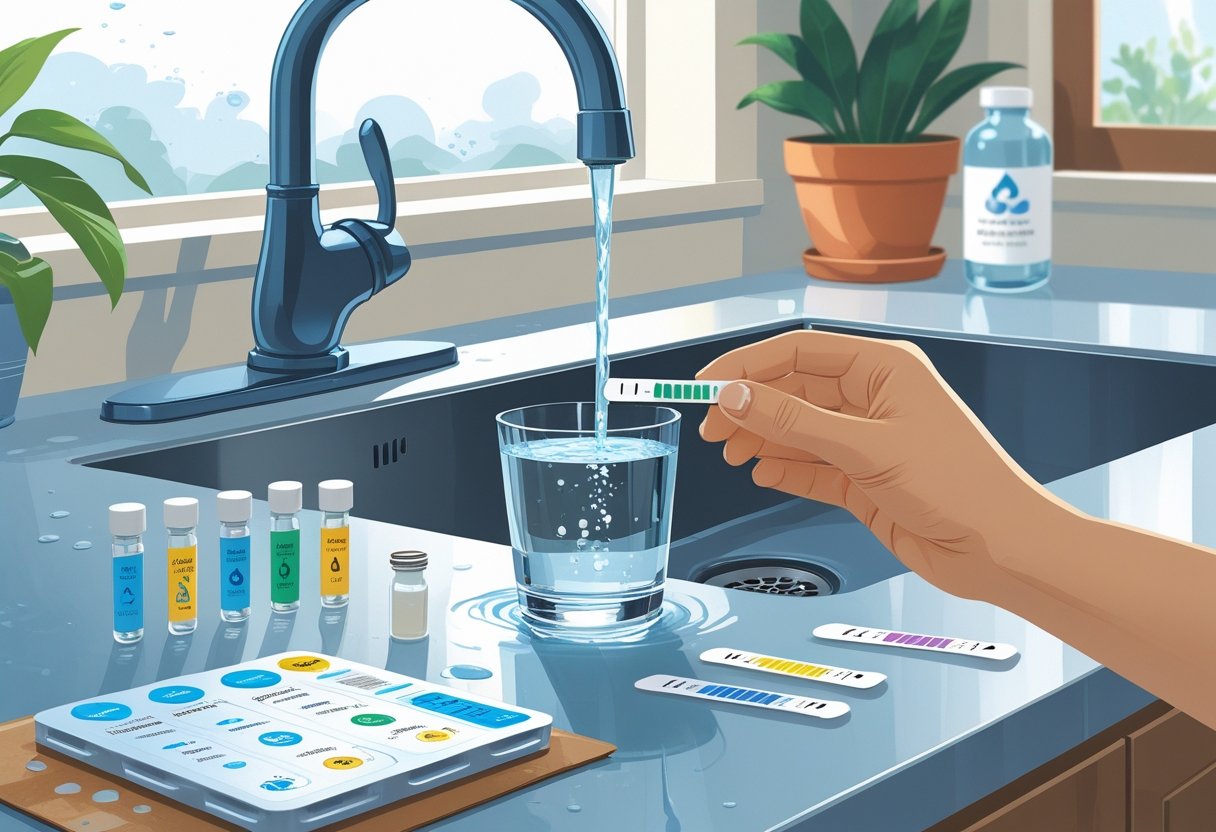Ensuring the safety of your tap water is essential for your health and well-being. To determine if your tap water is safe, start by testing it for contaminants using testing kits or professional services. Regular checks can provide peace of mind and identify potential issues before they affect your household.
You may wonder about the best methods for testing your water quality. Various options are available, ranging from simple home testing strips to comprehensive laboratory analyses. Understanding these methods not only equips you with the knowledge to safeguard your drinking water but also informs you about when to seek assistance from professionals like Pacific Backflow, who specialize in backflow testing and water safety throughout San Diego County.
Taking proactive steps to verify your tap water's safety can make all the difference. Being informed about water quality empowers you to protect your family and, if necessary, reach out for expert support to maintain a safe water supply in your home.
Why Testing Tap Water Safety Matters
Ensuring that your tap water is safe for consumption is vital for maintaining health and well-being. Regular testing helps identify potential contaminants and understand the sources of water quality issues.
Health Risks of Contaminated Water
Contaminated water poses significant health risks. Consumption of unsafe water can lead to gastrointestinal diseases, reproductive problems, and neurological disorders.
Common health effects include:
- Gastrointestinal issues: Contaminants like bacteria and viruses can cause severe stomach problems.
- Reproductive health: Chemicals, such as lead and arsenic, can negatively impact fertility and fetal development.
- Neurological disorders: Exposure to heavy metals can impair cognitive functions.
Your health should not be left to chance. Regular testing of your water helps ensure it meets safety standards and protects you from these risks.
Types of Water Sources
Tap water is primarily sourced from two types: municipal systems and private wells.
Municipal Systems:
- Water is treated and regulated by local authorities.
- Regular testing is usually done, but contamination can still occur due to aging infrastructure.
Private Wells:
- Homeowners are responsible for testing and maintaining water quality.
- More susceptible to contamination from nearby pesticides, nitrates, and other chemicals.
Understanding your water source helps you take necessary precautions. If you rely on a private well, frequent testing is essential to ensure safety.
Common Contaminants in Tap Water
Various contaminants can affect the safety of tap water. Being aware of these can guide your testing efforts.
Key contaminants include:
- Lead: Often found in old pipes, lead can cause serious health problems, especially in children.
- Arsenic: A naturally occurring element that can enter water supplies from geological sources.
- Pesticides and nitrates: These chemicals can seep into water from agricultural runoff, posing risks to your health.
Regular testing is crucial for detecting these contaminants early. At Pacific Backflow, we emphasize the importance of understanding water quality and provide services to ensure your water is safe for consumption.
Key Indicators of Tap Water Safety
Being able to identify key indicators of tap water safety is essential for ensuring good health. Certain visual and sensory evaluations can provide insight into potential contamination or quality issues.
Physical Observations and Sensory Evaluation
Start by conducting a simple visual inspection of your tap water. Look for any unusual characteristics like cloudiness, floating particles, or visible discoloration. Clear water is typically a positive sign, while a cloudy appearance may indicate the presence of suspended solids or high levels of total dissolved solids (TDS).
Next, use your senses. Fill a glass and observe the water. Swirl it gently and check for bubbles, which may signify issues with hard water. Pay attention to the smell; water should have a neutral odor. Any unusual or strong smells could suggest contamination. These preliminary observations can help you detect serious issues before heavy testing is warranted.
Water Color and Sediment
Water color plays a crucial role in assessing its safety. Ideal tap water should be colorless. If you notice a brownish, yellowish, or green hue, it may indicate rust or algae growth, suggesting contamination that could affect your health.
Sediment presence is another key indicator. After letting the water sit for a few minutes, check for any particles settling at the bottom. Sediment may indicate issues with your municipal supply or plumbing system. If you suspect high sediment levels, consider testing for pH levels and total dissolved solids to get a clearer picture of your water quality.
Taste and Odor Issues
A distinct taste or odor can indicate that your tap water may not be safe to drink. Acceptable water should taste fresh and clean. A metallic, bitter, or chemical taste can suggest the presence of contaminants, such as lead or chlorine, which are harmful at certain levels.
Similarly, if your water has an off-putting smell, it could signal bacterial contamination or the presence of organic materials. Conducting a basic taste and odor evaluation can help you determine if you need to dig deeper, possibly involving professional testing or filtration solutions. Always trust your instincts; if your water tastes or smells unusual, it’s worth investigating further.
Testing Methods for Tap Water Safety
To ensure your tap water is safe for consumption, various testing methods are available. Understanding how to use reliable testing methods can help identify potential contaminants in your drinking water. Here are some effective ways to assess water quality.
Using At-Home Water Test Kits
At-home water test kits offer a simple way to check your tap water for common contaminants. These kits often include test strips that can measure parameters like pH levels, hardness, and the presence of bacteria, including total coliform bacteria and E. coli.
Most kits also test for harmful chemicals such as nitrates and arsenic. To use a test kit, follow the instructions carefully. Dip the test strip in a water sample and wait for the color change that corresponds to the contaminant levels.
These kits provide quick results, allowing you to make informed decisions about filtering or further testing your water. For reliable options, consider products recommended by local water safety experts or services like Pacific Backflow.
Laboratory Testing for Detailed Analysis
For a comprehensive analysis of your water quality, lab testing is recommended. Unlike at-home kits, laboratories can perform detailed assessments, identifying a wider range of contaminants with greater accuracy.
The testing process typically involves collecting a water sample and sending it to a certified laboratory. They can test for various contaminants including heavy metals, organic compounds, and microbial pathogens. This method takes longer than at-home testing but delivers thorough results.
Laboratory testing is particularly useful if you suspect serious contamination. It allows local regulators or professionals like Pacific Backflow to suggest appropriate remediation steps based on accurate data.
Testing for Specific Contaminants
Certain contaminants require specialized testing methods. For instance, testing for nitrates and arsenic often necessitates specific analysis due to their potential health risks. High levels of nitrates can come from agricultural runoff and may affect infants and pregnant women.
Meanwhile, bacteria tests specifically for E. coli can indicate fecal contamination, posing health threats. It's crucial to perform these tests if you notice unusual tastes or odors in your water.
Using professionals who specialize in these analyses ensures accurate results. This targeted approach helps maintain your water supply's safety, addressing specific concerns effectively.
Special Considerations for Well Water and Private Wells
When it comes to ensuring the safety of well water, specific tests and regular monitoring are essential. Taking these steps will help you maintain the quality of your drinking water and protect your family's health.
Recommended Tests for Private Wells
You should perform several key tests to ensure the safety of your well water. Start with testing for nitrates and total coliform bacteria, including E. coli. These contaminants can significantly affect water quality and overall health. Regular testing for these substances is critical, especially if your well is near agricultural areas or septic systems.
Consider conducting a full water quality analysis at least once a year. This could include tests for heavy metals, pH levels, and other potential contaminants. You can contact your health department for guidance on appropriate laboratories and testing kits available in your area. Using reliable sources is crucial to gaining accurate results.
Frequency of Testing and Record Keeping
Regular testing helps you track any changes in your well water quality. You should aim to test your well water at least once a year, or more frequently if you notice any changes in taste, odor, or color. Situations like flooding or nearby construction may also trigger the need for additional tests.
Keep detailed records of your test results, including dates and the specific tests performed. This documentation can be valuable if you need to address problems or consult with professionals like Pacific Backflow. Their expertise can assist in mitigating potential risks related to your private well, ensuring compliance with local safety standards.
Improving Tap Water Quality After Testing
Once you have tested your tap water, understanding how to improve its quality is essential. Implementing the right solutions will help mitigate any contaminants or issues identified during testing.
Choosing the Right Water Filter
Selecting a suitable water filter is vital for enhancing water quality. There are various types of water filters, each designed for specific contaminants.
Types of Water Filters:
- Activated Carbon Filters: Effective in removing chlorine, sediment, and volatile organic compounds (VOCs).
- Reverse Osmosis Filters: Known for eliminating a broad range of contaminants, including heavy metals and bacteria.
- UV Filters: Utilize ultraviolet light to kill harmful pathogens.
When choosing a water filter, consider factors such as the specific contaminants identified in your test results and your water usage needs. Proper installation and maintenance of the filter will ensure its effectiveness. If you need assistance, companies like Pacific Backflow provide reliable services to help ensure your filtration systems are properly installed and functioning.
Using Water Softeners and Reverse Osmosis
Water softeners and reverse osmosis systems can significantly improve water quality, depending on your specific needs.
Water Softeners: These systems reduce hard water contaminants such as calcium and magnesium. This can lead to less lime scale buildup in appliances and improve the effectiveness of soaps and detergents.
Reverse Osmosis Systems: These are comprehensive solutions that filter water through semi-permeable membranes, removing a wide array of contaminants. They are particularly useful in areas with high levels of dissolved solids or hazardous substances.
Choosing between these options depends on your water quality issues. Regular maintenance of these systems is crucial, and for optimal results, it's advisable to consult professionals for installation and service. Engaging a company like Pacific Backflow can ensure that your systems remain compliant and effective.
Frequently Asked Questions
Testing the safety of your tap water is essential for ensuring your health. This section addresses common inquiries related to home water testing, methods to check for contaminants, and resources available in your area.
How can I test the safety of my tap water at home?
You can test your tap water using different methods. Purchasing a home water testing kit is one of the most straightforward ways to check for contaminants. These kits are readily available online or at local stores.
What are the methods to check if my drinking water is contaminant-free?
There are various methods for testing your drinking water. Besides home testing kits, you can send samples to a certified laboratory for detailed analysis. Local health departments might also provide testing services to assess water quality in your area.
Where can I find resources for free water testing in my area?
Many local health departments offer free or low-cost water testing services. Additionally, some non-profit organizations and community health initiatives may also provide free testing. Checking their websites or contacting them directly can help you find available resources.
What do water test kits analyze, and how can I use one?
Water test kits typically analyze for contaminants like lead, bacteria, nitrates, and pH levels. To use one, follow the instructions included in the kit, which usually entails collecting a water sample and using provided test strips or reagents to check for specific contaminants.
How do I interpret the results from a home water quality test?
Interpreting results from a home water quality test involves comparing your test results against established safety standards. Most kits come with a reference guide. If your results exceed acceptable levels for any contaminant, consider seeking further testing or remediation options.
Are there reliable ways to test water quality without a kit?
Yes, you can conduct a visual inspection to spot discoloration or unusual odors. Additionally, you may contact your local water supplier to request a water quality report, which typically includes information on contaminants and overall safety. If you have concerns, consulting a professional service like Pacific Backflow could provide further assurance.










